
Alders are trees comprising the genus Alnus in the birch family Betulaceae. The genus comprises about 35 species of monoecious trees and shrubs, a few reaching a large size, distributed throughout the north temperate zone with a few species extending into Central America, as well as the northern and southern Andes.

Rhododendron is a very large genus of about 1,024 species of woody plants in the heath family (Ericaceae). It is either evergreen or deciduous. Most species are native to eastern Asia and the Himalayan region, but smaller numbers occur elsewhere in Asia, and in North America, Europe and Australia. It is the national flower of Nepal, the state flower of Washington and West Virginia in the United States, the state flower of Nagaland in India, the provincial flower of Jiangxi in China and the state tree of Sikkim and Uttarakhand in India. Most species have brightly colored flowers which bloom from late winter through to early summer.

Azaleas are flowering shrubs in the genus Rhododendron, particularly the former sections Tsutsuji (evergreen) and Pentanthera (deciduous). Azaleas bloom in the spring, their flowers often lasting several weeks. Shade tolerant, they prefer living near or under trees. They are part of the family Ericaceae.

The Hong Kong Zoological and Botanical Gardens is one of the oldest zoological and botanical centres in the world, and the oldest park in Hong Kong. Founded in 1864, its first stage was opened to the public in 1871. It occupies an area of 5.6 hectares, in Central, on the northern slope of Victoria Peak.

Arisaema is a large and diverse genus of the flowering plant family Araceae. The largest concentration of species is in China and Japan, with other species native to other parts of southern Asia as well as eastern and central Africa, Mexico and eastern North America. Asiatic species are often called cobra lilies, while western species are often called jack-in-the-pulpit; both names refer to the distinctive appearance of the flower, which consists of an erect central spadix rising from a spathe.

The State Botanical Garden of Georgia is a botanical garden of 313 acres in the United States, with a conservatory operated by the University of Georgia. It is located at 2450 South Milledge Avenue, Athens, Georgia.

Lycoris is a genus of 13–20 species of flowering plants in the family Amaryllidaceae, subfamily Amaryllidoideae. They are native to eastern and southern Asia in China, Japan, southern Korea, northern Vietnam, northern Laos, northern Thailand, northern Burma, Nepal, northern Pakistan, Afghanistan, and eastern Iran. They were imported into North Carolina and now grow wild. In English they are also called hurricane lilies or cluster amaryllis. The genus shares the English name spider lily with two other related genera.

Aletris, the colicroot, colicweed, crow corn, or unicorn root, is a genus of flowering plants in the family Nartheciaceae, native to North America and to eastern and southeastern Asia, especially China. It was used as a component in Lydia Pinkham's original Vegetable Compound.

Linnaea is a plant genus in the honeysuckle family Caprifoliaceae. Until 2013, the genus included a single species, Linnaea borealis. In 2013, on the basis of molecular phylogenetic evidence, the genus was expanded to include species formerly placed in Abelia, Diabelia, Dipelta, Kolkwitzia and Vesalea. However, this is rejected by the majority of subsequent scientific literature and flora.
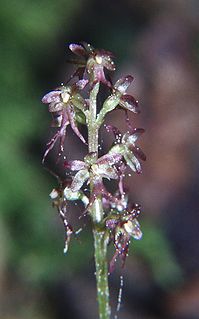
Neottia is a genus of orchids. The genus now includes the former genus Listera, commonly known as twayblades referring to the single pair of opposite leaves at the base of the flowering stem. The genus is native to temperate, subarctic and arctic regions across most of Europe, northern Asia, and North America, with a few species extending into subtropical regions in the Mediterranean, Indochina, the southeastern United States, etc.

The Rhododendron-Park Bremen, also known as the Rhododendron-Park und Botanischer Garten Bremen, is a major collection of rhododendrons and azaleas, as well as a substantial botanical garden, located in Bremen, Germany. It is open daily; park admission is free but a fee is charged for the nature center Botanika.

Rhododendron section Tsutsusi was a subgenus of the genus Rhododendron, commonly referred to as the evergreen azaleas. In 2005 it was reduced to a section of subgenus Azaleastrum. Containing 80 - 117 species, it includes both deciduous and evergreen types and is distributed in Japan, China and northeastern Asia. They are of high cultural importance to the Japanese. Among the species in this genus lie the largest flowering azaleas.
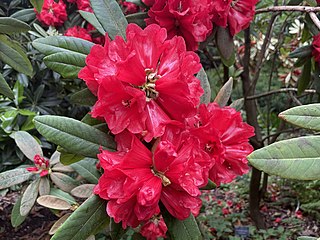
Rhododendron facetum (绵毛房杜鹃) is a species of flowering plant in the family Ericaceae. It is native to northeast Myanmar, northern Vietnam, and western Yunnan, China, where it grows at altitudes of 2,100–3,600 m (6,900–11,800 ft). It is a shrub or small tree that grows to 3–7 m in height, with leathery leaves that are oblong-elliptic to obovate-elliptic, 8.5–20 by 3–6 cm in size. Flowers are red with deeper colored spots.
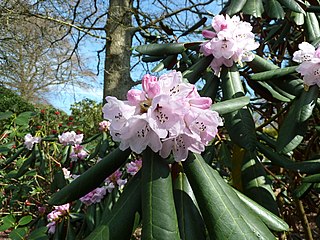
Rhododendron fulvum is a species of flowering plant in the heath family Ericaceae, native to northern Myanmar and China. In China, it is found in southwest Sichuan, southeast Xizang, and western Yunnan. It grows at altitudes of 2,700–4,400 m (8,900–14,400 ft). It is an evergreen shrub or small tree growing to 2–8 m (6.6–26.2 ft) in height, with leathery leaves that are oblanceolate to oblong-lanceolate or obovate, 8–20 by 3–7.5 cm in size. The undersides are felted with a striking cinnamon colour. The flowers, borne in trusses in spring, are loosely bell-shaped, pale rose pink, with a crimson basal blotch and sometimes red spots.
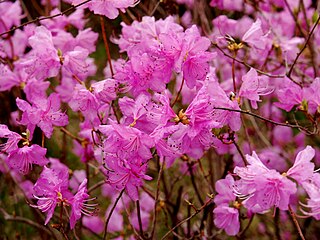
Rhododendron mucronulatum, the Korean rhododendron or Korean rosebay, is a rhododendron species native to Korea, Mongolia, Russia, and parts of northern China. It is a deciduous shrub that grows to 1–2 m (3.3–6.6 ft) in height, with elliptic or elliptic-lanceolate leaves, 3–7 cm long by 1–3.5 cm wide. The reddish-purple flowers appear in late winter or early spring, often on the bare branches before the foliage unfurls. It inhabits forested regions at 1,600–2,300 m (5,200–7,500 ft).

Rhododendron subsection Tsutsusi is a subsection of the genus Rhododendron, in section Tsutsusi, subgenus Azaleastrum, consisting of 66 species of Azaleas.

Rhododendron serpyllifolium (ウンゼンツツジ) is a rhododendron species native to Honshu, Kyushu, and Shikoku, Japan. It is a shrub that grows to 120 cm. (4 ft.) in height. Flowers are white to pink.

Rhododendron sinogrande (凸尖杜鹃) is a species of flowering plant in the family Ericaceae. It is commonly called the great Chinese rhododendron, and is native to alpine regions at 2,100–3,600 m (6,900–11,800 ft) in southeastern Xizang and western Yunnan in China and in northeastern Myanmar.
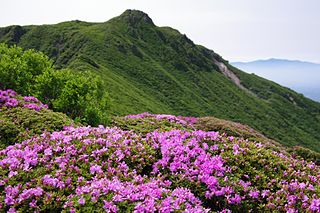
Rhododendron kiusianum, the Kyushu azalea, is a species of flowering plant in the family Ericaceae, native to Kyushu, Japan. It is a parent of a large number of hybrid dwarf azaleas. It is the official flower of Unzen, Nagasaki, and of Kagoshima Prefecture.

Rhododendron tatsienense is a species of flowering plant in the family Ericaceae, native to south-central China. It resembles Rhododendron davidsonianum and R. siderophyllum.




















